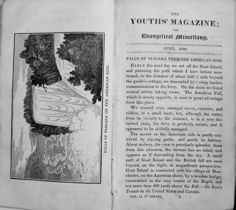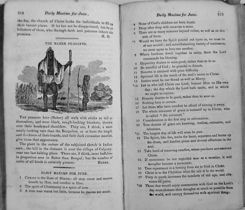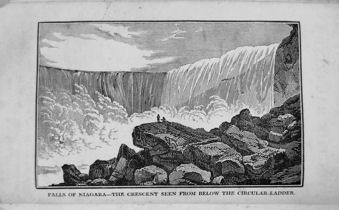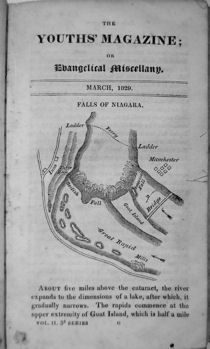|
The Youth's Magazine; or, Evangelical Miscellany, 1805–67 | |
Sequence |
Third Series, Volumes 1–10 (1828–37) |
Editor |
John Campbell |
Publisher |
Hamilton,
Adams & Co. (1828–37+) |
Printer |
H. Heape (1808–49+) |
Price |
4d. (1828) |
Format |
Demy 12mo. |
Pages |
36 (1828) |
Frequency |
Monthly |
Circulation |
c. 10,000 (1830) |
Indexes |
All volumes: Index to the Prose, Index to the Poetry, Index to the Plates, Wood Cuts, and Music |
Copies |
British Library, Document Supply Centre, Boston Spa (vols 1,
3–10) |
Introduction | |
 The Youth's Magazine was founded in 1805 as a monthly magazine for the older children of middle-class Christian households of an evangelical bent. It was the inspiration of a group of individuals involved in the largely nonconformist Sunday School Union (SSU), which had been founded only two years previously. Having conceived the magazine, however, the SSU committee was concerned lest it should prove a failure, and incur a loss which the fledgling organization could ill afford. As a result, it was developed as a private project by members of the committee, although it continued to be closely associated with the SSU. In the event, the magazine's success meant that, contrary to the committee's fears, the editors were able to donate £225 to the SSU from the profits in the first twenty-two years, a further £1335 going to other good causes. Nevertheless, the fears of the committee concerning the possibility of commercial failure were not ill-founded. Although there had been several earlier children's periodicals, the Youth's Magazine was the first to achieve sustained success. In part, the new magazine's prosperity can probably be attributed to the continuing growth in demand for books aimed at middle-class children, which had become a significant sector of the developing market for leisure books in later eighteenth-century Britain. In addition, however, the Youth's Magazine had two significant advantages over merely commercial productions, arising from its conception within the SSU: first, its impeccably pious credentials were well-suited to the requirements of many parents within the often dissenting middle classes; and secondly, the SSU provided a ready-made distribution network through which copies of the magazine could be circulated and new contributions generated.  The magazine's character and tone were comprehensively religious, although beyond its broadly based evangelicalism it disavowed a connection to 'any Sect or Party whatever' and claimed that it was run on 'liberal principles'. According to an 1827 prospectus, the magazine's 'grand object' was to 'promote the cause of Real Religion among the youth of both sexes, avoiding every thing controversial, and pointing the youthful mind to the WORD of GOD as the only pure source of Religious Knowledge'. Its content was not, however, restricted to religious topics. Rather, the magazine provided a miscellany of factual articles, moral tales, essays, homilies, extracts from religious and other books, and poetry. The 1827 prospectus averred that the editors endeavoured to combine the extension of 'Real Religion' with 'the intellectual advancement of the young', in whom they sought to 'create a taste for reading, and a desire to improve their time and talents'. It was to this end that they included 'Illustrations of Scripture, accompanied by Wood Cuts and Maps; Original Narratives, and Essays upon moral and religious topics; useful and entertaining Information of various kinds; interesting Facts and Anecdotes, and Memoirs of pious Young Persons; with original Poetry and Music'. The production of the Youth's Magazine was heavily dependent on the voluntary contributions of members of the largely nonconformist network who ran the SSU. The editorship seems to have been a co-operative enterprise. During the first series, the independent minister John Campbell (1795–1867) and the Baptist shorthand writer William Brodie Gurney (1777–1855) were prominent members of the editorial staff. Gurney, who was successively secretary, treasurer, and president of the SSU, continued to be involved with the magazine until his death in 1855, and was for thirty years its treasurer. Another significant figure was William Freeman Lloyd (1776–1856), who as secretary of the SSU from 1810 was the driving force behind that organization. Contributions were generally pseudonymous, but more frequent contributors clearly became known to readers. Particularly notable contributors included, between 1816 and 1822, the Independent children's writer Jane Taylor (1783–1824,'QQ') and, during the third series, the Anglican children's writer Mary Martha Sherwood (1775–1851, 'MMS') and the Independent minister Richard Cope (1776–1856, 'RC').  As already stated, the magazine also owed its success in part to its use of the SSU distribution network, which by 1835 consisted of around 8000 Sunday schools and a million enrolled students. The SSU saw the distribution of suitable books as a key aspect of its mission, and by the 1830s its Paternoster Row depository had an annual turnover of more than one million items at a retail value of around £8000. Catalogues and sample copies of books were sent direct to Sunday schools, and much of the trade was handled by post. The Youth's Magazine benefited from this privileged distribution system. Moreover, once the second series of the magazine had completed, the SSU purchased the back copies and offered them for sale at reduced prices as being particularly suitable for Sunday school libraries. In addition, however, the magazine was available for purchase through normal trade channels, and was published during the third series by the evangelical publishing and wholesale house, Hamilton, Adams, & Co. The monthly numbers of the Youth's Magazine ran to thirty-six duodecimo pages, and were priced at fourpence. Each number contained at least one wood engraving, printed on a separate page to appear like an intaglio plate, and sometimes further illustrations were incorporated within the letter-press. In addition, an eightpenny supplement was issued at the end of each year, containing the index, an engraved titlepage and frontispiece, and a further four steel-plate engravings. Thus, while the Youth's Magazine was cheap relative to most adult periodicals, its production values clearly marked it out as aiming at a middle-class market, an impression confirmed by the social references given in the fiction it contained. By the 1820s, this formula was being imitated by other religious organizations, notably the Wesleyan-Methodist Church, which from 1817 issued a fourpenny Youth's Instructer and Guardian. In 1825, the latter was circulating 12,500 copies per month, and the Youth's Magazine's circulation was apparently a little lower at around 10,000 copies per month. While these figures are large by contemporary standards, they are markedly lower than those for the penny 32mo periodicals which began to be issued for younger and or less wealthy children in 1824, including the Religious Tract Society's Child's Companion (28,000) and the Wesleyan Child's Magazine (36,000). | |
Notes on Indexing | |
 The portion of the Youth's Magazine indexed here comprises the third series (1828–37) and provides an insight into the presentation of science to children within a religious context just at the period when secular educational provision was beginning to cause Christian commentators serious concern. Given its religious preoccupations, the extent of the Youth's Magazine treatment of scientific topics might at first seem surprising. In the third series, most issues had at least a couple of articles dealing explicitly with scientific topics of various kinds. However, this is entirely in keeping with the magazine's design to introduce its readers to secular learning within a sacred context. The prospectus for the third series boasted that it had been 'the first periodical for the young that combined Evangelical instruction with useful information'. For the editors of the Youth's Magazine, the new 'useful knowledge' publications of the Society for the Diffusion of Useful Knowledge, together with the fashionable books of travels and exploration of the post-war years, presented a real danger to youth. Only by constantly relating such material to scriptural truth, they asserted, and to the life of Christian devotion, could young people hope to avoid being drawn away from the true path by worldly concerns. These preoccupations are not universally apparent in the magazine's treatment of science. For instance, a brief article on the 'Papyrus, or Paper Rush' might describe in mundanely secular terms the plant and the history of its use in paper manufacture. Nevertheless, it was more typical for such informative articles also to include a reference to the Bible, to God's activity in nature, or to some aspect of religious devotion (such as the bee providing an example of industry). The first of these was particularly prominent, and often scientific material was used to illustrate or provide independent testimony of the truths of scripture. Accounts of natural phenomena also often made reference to God's relationship to the created order—particularly to instances of divine design—but such references were checked by evangelical misgivings concerning the formal arguments of natural theology. Natural reasoning, unaided by divine revelation, was generally seen to be highly subject to error, and it was usually considered best to interpret nature by the light of scripture. The interweaving of religious concerns and secular knowledge was not only manifested in the dedicated scientific articles. It also frequently arose in the many moral tales and homilies which formed the bulk of the magazine. The tales provided powerful exemplars of how secular knowledge could be incorporated into the religious lives of middle-class children. Sometimes these were cautionary tales; at other times they provided positive role models of parents and children who were able to combine the study of secular works and of nature itself with appropriately scriptural religious associations. The pious approach to secular learning was also enforced in more direct ways in homilies and other articles which urged readers to adopt particular practices of observation, thought, and reading. In indexing the dedicated scientific articles it has generally proved possible to succinctly summarize the subjects covered, without an elaborate description. By contrast, the references to the sciences appearing in fiction have generally required more detailed description in order to be understood. This also applies in the case of many of the essays and homilies, where scientific references often occur as part of an elaborate discussion or argument. Finally, there are numerous passing references to scientific themes in the extensive poetry section, and here, the indexing often depends upon extended quotation in order to convey the sense. | |
Bibliography | |
Bratton, J. S. 1981. The Impact of Victorian Children's Fiction. London: Croom Helm. Laqueur, Thomas Walter 1976. Religion and Respectability: Sunday Schools and Working Class Culture, 1780–1850. New Haven, Conn.: Yale University Press. Topham, Jonathan R. 2004. 'Periodicals and the Development of Reading Audiences for Science in Early Nineteenth-Century Britain: The Youth's Magazine, 1828-37', in Culture and Science in the Nineteenth-Century Media, ed. Louise Henson et al., Aldershot: Ashgate, 57–69. Topham, Jonathan R. 2004. 'The Wesleyan-Methodist Magazine and Religious Monthlies in Early Nineteenth-Century Britain', in Reading the Magazine of Nature: Science in the Nineteenth-Century Periodical, ed. by Geoffrey Cantor et al., Cambridge: Cambridge University Press, 67–90. | |
Jonathan R. Topham | |